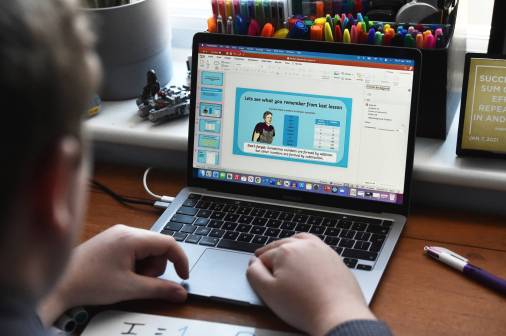New ISTE chief Richard Culatta outlines early vision for national edtech group

Richard Culatta knows how to grab a crowd’s attention. Standing before a noisy audience of edtech leaders gathered for presentations at a Senate hearing room in Washington, D.C., last week, Culatta stepped up on a tabletop at the front of the room, microphone in hand and called the session to order, lightheartedly explaining it’s a trick that seems to work with high school students.
Culatta, however, is also known as an enthusiastic force within education technology circles. He helped shape the National Education Technology Plan during his four years directing the U.S. Department of Education’s Office of Educational Technology. And for the past year and a half, he led a variety of initiatives as chief innovation officer for the State of Rhode Island while also serving as a design resident at IDEO, the global design firm.
That was before he stepped onto a larger national stage, beginning this month, as the new CEO of the International Society for Technology in Education.
EdScoop caught up with Culatta to discuss his vision for ISTE following a whirlwind day in Washington where he and leaders from ISTE, the Consortium of School Networking (CoSN) and the State Education Technology Directors Association (SETDA) had stormed Capitol Hill to reiterate the importance of federal broadband funding for schools. The following interview has been edited for brevity.
EdScoop: What’s emerging as your agenda for both the association and the larger community that ISTE’s trying to influence.
Richard Culatta: Even as long-time ISTE member, I was not aware of how much ISTE does to support the education community. Everyone knows about our conference, but ISTE also provides a whole range of online professional learning opportunities and vibrant online communities where people can continue the conversation long after a conference is over. So one area of focus will be on raising the awareness of the wide range of learning opportunities available for members to grow in their practice.
In terms of the broader community, it comes down to really thinking about how technology can be a catalyst to addressing long-standing challenges in the field. Whether we’re talking about closing equity gaps, improving teacher preparation, bridging research and practice, or personalizing instruction – technology plays a key role in accelerating the solutions.
ISTE brings a deep understanding of how technology can accelerate those topics through the work our members are doing in classrooms to the communities they serve. It’s exciting! But, it’s a little different than just saying, “How do we teach math on a computer?” It’s really rethinking the design of learning through technology.
Can you talk about what strategic initiatives need to happen to make ISTE either more functional, deliver new services or support, or tackle some of the things you’d like to see done?
ISTE members are really incredible, in part because they tend to be the early adopters, the first to raise their hand to try new things. While we will always be a community of innovators, we also need to find ways to expand our membership, to include people who could benefit from the shared knowledge of our community. Particularly instructional leadership — a chief academic officer or head of curriculum and instruction. Those are people with whom ISTE can share how technology can support their vision for learning in their school.
We also need to think about how we are supporting our higher education colleagues. The K-12 side has made some incredible leaps in the last few years around how technology is being used for learning. But we have students who are graduating high schools and walking into colleges that look like they’re still in the 60s, in terms of how instruction is delivered — very traditional, with the instructor standing in front of a class. I think it is critical to support a transition to using technology to personalize learning and increase collaboration in postsecondary education in the same way we have seen recently in elementary education.
That’s an area where I think we can be very helpful. ISTE actually began as a higher education organization, a lot of people don’t know that. Now, of course, we support much more the K-12 community, but we’ll really be thinking about how to support our higher education colleagues as well.
Talk about your experience in Rhode Island in trying to foster innovation. What things did you start doing in Rhode Island that you think will find a larger footing now in ISTE?
My work in Rhode Island centered around creating a community of innovators, from across domains and organizations, to tackle tough challenges. Gov. Gina Raimondo had a goal to create a “lab state” for education innovation and that’s what we did.
That led to a number of state-based initiatives. Rhode Island is the first state to have a statewide vision for personalized learning. It’s also the only state where all higher education institutions pledged to transition from commercial to open licensed textbooks. And Rhode Island is on track to become the first state to have computer science offered in every K-12 school. So the idea of pulling people together to work to accelerate innovation is an approach that I will continue to use.
I will also continue to look for ways to help accelerate the adoption of computer science. I think teaching computer science is a critical skill for the future because the solution to almost every tough problem, at some point along the way, involves code. If we aren’t preparing our kids to be familiar with computer science, we’re outsourcing our ability to problem solve. That’s scary to me. ISTE already has computer science teacher standards and we will take a renewed focus on how we can support computer science across the country.
As the architect for the Department of Education’s National Technology Education Plan, prior to going to Rhode Island, what are your thoughts on how the plan is being carried out? And what still needs to happen, and how might ISTE potentially play a role?
The National Ed Tech Plan laid out a vision for how technology could be used in very practical ways. I think the plan continues to provide a north star. What we need now are more examples we can point to. A key role for ISTE is to continue to highlight and tell the story of teachers, schools and colleges that are really getting it right — figuring out how to use technology to empower learners. It’s not just about delivering content, but empowering learners to be designers and builders and creators. I think the more we highlight that, the easier it becomes for other people to follow.
What’s your perspective moving from the national level, at the Department of Education, to a state level and how much states can be a driving force for capitalizing on technology in education?
I believe that states are a very powerful driving force for creating the future of education. But I’ll warn from experience that it’s not easy. If we want states to become engines of innovation, we’re also going to have to provide more supports to help develop the talent to help deliver on this sort of innovation, to help create a vision for the future of learning, and to help build partnerships with the right people and organizations. I’m very optimistic about what states can do, but we have some work to do to make sure they are able to be the effective driving force that they could be.
What’s your message, if you have one for the education technology industry, about the job they need to do, say around data privacy or simply being more supportive to the needs of schools to integrate technology and instruction?
I think we need better collaboration between technology providers, researchers and educators — we need to do a better job of jointly building solutions.
There is a movement underway to create education innovation clusters, where the various groups regularly meet. It’s important to have all the groups sitting at the table asking “How can research inform building technology? How practice can inform new solutions? And how technology accelerate policy goals?”
Conversations where everybody’s sitting at the table are critical, and we don’t have enough of them. That’s an area where we could all do better.




